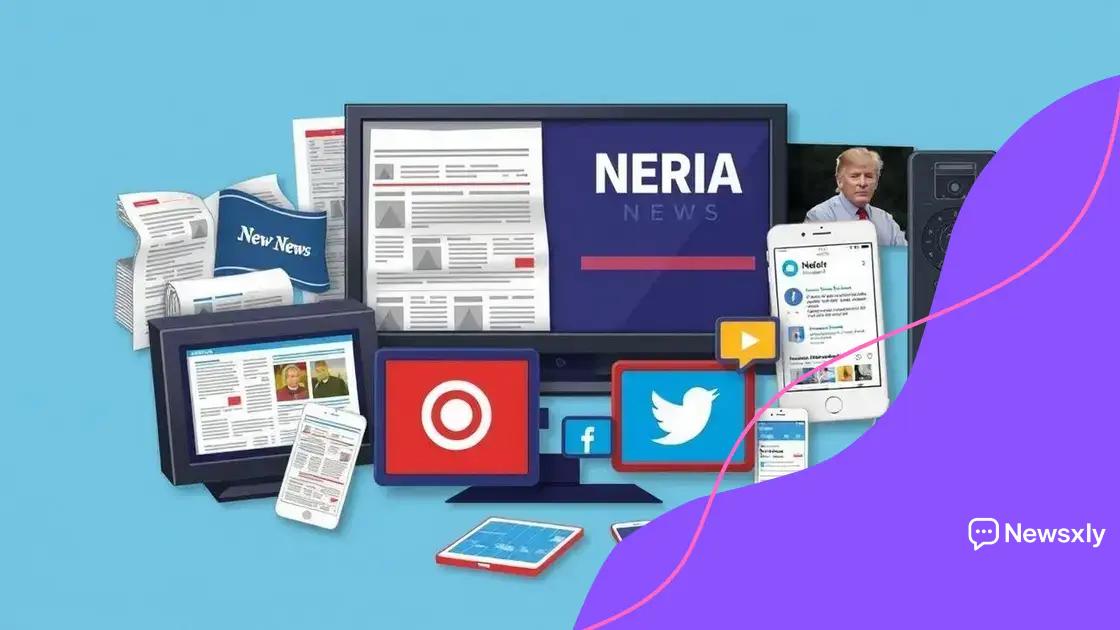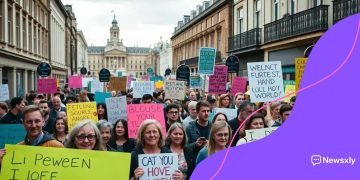Public opinion on significant policy matters: what it means

Public opinion on significant policy matters directly influences policy changes in areas like healthcare, climate change, and gun control, driven by factors such as media, personal experiences, and collective sentiment.
Public opinion on significant policy matters plays a crucial role in shaping the decisions that impact our daily lives. Ever wondered how your voice influences lawmakers? Let’s dive into the dynamics of this important topic.
Understanding public opinion: key definitions
Understanding public opinion is crucial for grasping how it influences significant policy matters. It reflects the beliefs, attitudes, and preferences of the general populace. In its essence, public opinion serves as a barometer of what people think about various issues, from healthcare to education reform.
Key Definitions of Public Opinion
To delve into public opinion, we must first clarify a few key terms:
- Public Opinion: The collective sentiments and viewpoints of the population on a particular issue.
- Survey: A method for gathering data about public opinion through questionnaires and interviews.
- Focus Group: A small, diverse group of people whose reactions are studied to gauge feelings on a specific topic.
- Polling: The process of measuring public opinion through statistical sampling.
These terms lay the groundwork for understanding how public opinion operates in society. Each plays a vital role in shaping our perception of significant issues.
The Importance of Public Opinion
The importance of public opinion cannot be overstated. It directly influences government decisions, legislative processes, and even the priorities of political leaders. When people express their views, they impact policymaking at all levels.
Moreover, public opinion is not static; it evolves with changing social dynamics and information dissemination. For instance, the rise of social media has transformed how opinions are formed and shared. Now, voices that were once marginalized can significantly affect public discourse.
In understanding public opinion, one also needs to consider its limitations. While it provides insight into collective beliefs, it might not always reflect informed viewpoints. Many factors can distort public perception, such as misinformation or media bias.
Factors influencing public opinion on policies
Many factors influence public opinion on policies. Understanding these factors is essential for grasping how public sentiments shape political landscapes. It’s not just about what people think; it’s also about why they think it.
Key Influencers
Several key elements play a role in shaping public opinion:
- Media Coverage: The way issues are presented in the media can significantly affect public perception. Coverage can highlight certain aspects or downplay others.
- Personal Experience: Individuals often base their opinions on personal encounters with policies or related issues. Their experiences directly shape their beliefs.
- Social Networks: Friends and family contribute to shaping perspectives. Discussions within these networks can lead to stronger opinions, either for or against policies.
- Political Ideology: People’s political beliefs guide their views on policies. Those with strong ideological commitments might view issues differently than those without.
Furthermore, demographic factors such as age, gender, education, and socioeconomic status also influence how people perceive policies. Younger individuals may prioritize different issues compared to older generations, while education level can affect understanding and opinions on complex topics.
The timing of events also matters. For example, a major event or crisis can shift public opinion quickly. People may react strongly to events that resonate with their values or spark fear, thus altering their viewpoints.
Another important factor is the influence of interest groups and advocacy organizations. These groups often push specific narratives that can sway public opinion, especially on issues where they have vested interests. By mobilizing supporters and utilizing media campaigns, they can create momentum for particular views.
The role of media in shaping opinions

The media plays a vital role in shaping opinions on significant policy matters. From news outlets to social media, the information we consume directly affects how we view the world. Understanding this influence is essential for grasping the dynamics of public opinion.
Types of Media and Their Impact
Different types of media impact public opinion in various ways:
- News Reports: Traditional news organizations provide information that can sway public perceptions. The angle taken in reporting can significantly color how issues are understood.
- Social Media: Platforms like Twitter and Facebook allow for rapid sharing of information and opinions. They create echo chambers where specific views are amplified.
- Opinion Pieces: Editorials or op-eds can shape opinions by presenting arguments or insights that resonate with the audience. They encourage readers to think about issues from new perspectives.
- Documentaries and Podcasts: These formats provide in-depth examinations of topics, allowing audiences to engage deeply with complex issues.
Moreover, media can also set the agenda by focusing on specific issues over others. This agenda-setting influences what people consider important and worthy of discussion. When the media highlights certain topics, public interest typically follows, leading to increased awareness and debate.
It is also crucial to recognize the potential for media bias. Different outlets may have different ideological leanings, affecting the presentation of facts. When audiences consume biased information, their perceptions can become skewed, leading to divided opinions on policies.
In recent years, the rise of misinformation has complicated the media’s role even further. False information can spread quickly, shaping public opinion in harmful ways. It is important for consumers to critically evaluate the sources and accuracy of the information they encounter.
How public opinion is measured and analyzed
How public opinion is measured and analyzed is crucial for understanding its impact on policies. Various methods are employed to capture the thoughts and feelings of the public on significant issues. Each method has its strengths and weaknesses, offering insights into how opinions are formed and transformed over time.
Common Methods of Measurement
Several common methods are utilized to gather data on public opinion:
- Surveys: Surveys are among the most popular ways to measure public opinion. They involve structured questionnaires that can be distributed face-to-face, online, or via phone interviews.
- Polls: Polls, which often focus on specific issues or candidates, provide quick snapshots of public sentiment. These are typically conducted through random sampling to ensure diverse representation.
- Focus Groups: Focus groups bring together a small number of individuals to discuss their views on topics. This qualitative method allows researchers to explore the depth of feelings and the reasoning behind opinions.
- Social Media Analysis: Analyzing social media platforms reveals trends in public opinion. By examining posts, shares, and comments, researchers gauge public sentiment on various topics.
While these methods are effective, they can also have biases. Survey responses might be influenced by the wording of questions, while social media might not accurately represent broader public sentiment due to demographic limitations.
Analyzing Public Opinion Data
Once data is collected, it is analyzed to draw meaningful insights. Researchers use statistical methods to interpret survey results, looking for patterns and trends. For example, they may segment data by demographics to understand how different groups perceive an issue.
With social media analysis, algorithms can detect sentiment by using natural language processing. This technology helps identify whether posts are positive, negative, or neutral. Additionally, tracking changes over time can highlight evolving opinions and the impact of significant events.
The analysis is crucial for policymakers. They use this knowledge to shape decisions and gauge public support for initiatives. Understanding public opinion can lead to more effective communication strategies and policy adjustments, making it a powerful tool in governance.
Examples of policies affected by public sentiment
Many significant policies are influenced by public sentiment. Understanding these examples can provide insight into how opinions shape governance and decision-making. Here are several notable instances where public opinion has played a crucial role in policy changes.
Healthcare Reform
In many countries, healthcare policies have had to adapt to changing public opinions. For example, in the United States, public support for the Affordable Care Act (ACA) increased as more people began to understand its benefits. When individuals saw improvements in access to healthcare, their support solidified, pressuring lawmakers to maintain or expand such programs.
Climate Change Initiatives
Public sentiment around environmental issues has seen a significant shift in recent years. As awareness of climate change grows, so does support for policies aimed at combatting it. Grassroots movements and youth activism have pushed governments to adopt stricter environmental regulations and commit to renewable energy sources.
- Paris Agreement: Public support has influenced nations to commit to climate goals.
- Local Sustainability Efforts: Communities advocating for green spaces and clean energy have led to new local ordinances.
- Carbon Tax Implementation: Growing concern over climate change has swayed opinion in favor of taxing carbon emissions to reduce pollution.
Governments often respond to this increasing public demand for action on climate change by proposing more ambitious environmental policies. Public rallies, petitions, and social media campaigns have reinforced the urgency of these issues.
Gun Control Laws
Gun control is another area where public sentiment has had a significant impact. In the aftermath of high-profile mass shootings, public outrage has often prompted calls for stricter gun laws. Organizations advocating for gun control have mobilized citizens, leading to legislative changes in various states.
Polls indicate that a majority of citizens support measures such as background checks and restrictions on certain firearms. Lawmakers have responded to these sentiments by introducing and voting on new legislation aimed at enhancing public safety.
These examples highlight how public sentiment can drive policy changes across different sectors. When citizens express their opinions through voting, activism, or dialogue, they can significantly shape the direction of government action.
FAQ – Frequently Asked Questions about Public Opinion on Policy Matters
What are the main factors influencing public opinion on policies?
Key factors include media coverage, personal experiences, social networks, and political ideology.
How is public opinion measured?
Public opinion is typically measured through surveys, polls, focus groups, and social media analysis.
Can public sentiment really change policies?
Yes, public sentiment can significantly drive policy changes in areas like healthcare, climate change, and gun control.
What role does media play in shaping public opinion?
Media influences public opinion by highlighting certain issues, providing information, and sometimes creating biases based on the coverage.





